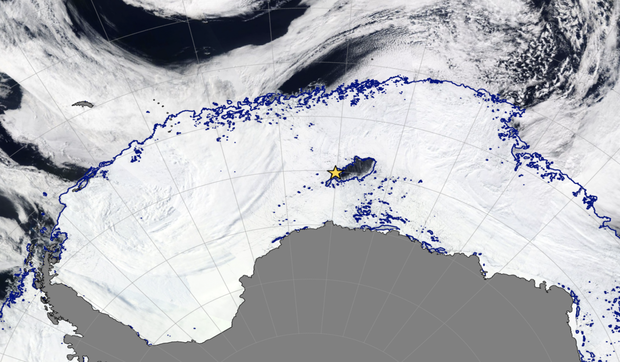Winter sea ice blankets the Weddell Sea around Antarctica with massive extra-tropical cyclones hovering over the Southern Ocean in this satellite image from September 25, 2017. The blue curves represent the ice edge.
The polynya is the dark region of open water within the ice pack.
Photograph Courtesy of MODIS-Aqua via NASA Worldview; sea ice contours from AMSR2 ASI
Photograph Courtesy of MODIS-Aqua via NASA Worldview; sea ice contours from AMSR2 ASI
via University of Bremen
From National Geographic by Heather Brady
A mysterious hole as big as the state of Maine has been spotted in Antarctica’s winter sea ice cover.
The hole was discovered by researchers about a month ago.

The blue curves represent the ice edge, and the polynya is the dark region of open water within the ice pack.
Photograph Courtesy of MODIS-Aqua via NASA Worldview; sea ice contours from AMSR2 ASI via University of Bremen
Photograph Courtesy of MODIS-Aqua via NASA Worldview; sea ice contours from AMSR2 ASI via University of Bremen
Known as a polynya, this year’s hole was about 30,000 square miles at its largest, making it the biggest polynya observed in Antarctica’s Weddell Sea since the 1970s.
“In the depths of winter, for more than a month, we’ve had this area of open water,” says Kent Moore, professor of physics at the University of Toronto.
“It’s just remarkable that this polynya went away for 40 years and then came back.”
Localization of the polynya on the GeoGarage platform (NGA chart)
Sea ice and clouds blanket the Weddell Sea around Antarctica in this satellite image from September 25, 2017. The dark area marked by the star is the polynya.
University of Bremen
University of Bremen
The harsh winter in Antarctica makes it hard to find holes like this one, so it can be difficult to study them.
This is the second year that a polynya formed, though last year’s hole was not as big. Scientists knew to monitor the area for polynyas this year because of last year’s discovery.
As these ice gaps typically form in coastal regions, however, the appearance of a polynya ‘deep in the ice pack’ is an unusual occurrence.
The Weddell Polynya can be seen in the Southern Ocean, above
The deep water in that part of the Southern Ocean is warmer and saltier than the surface water.
Ocean currents bring the warmer water upwards, where it melts the blankets of ice that had formed on the ocean’s surface.
That melting created the polynya.
Since the hole continually exposes the water to the atmosphere above, it is difficult for new ice layers to form.
When the warmer water cools, on contact with the frigid temperatures in the atmosphere, it sinks.
Then it reheats in deeper areas, allowing the cycle to continue.
Moore says they are working to understand what is triggering the formation of these holes again after so many years.
He thinks it is likely that marine mammals could be using this new opening to breathe.
The cooling of the warmer ocean water when it reaches the surface may also have a broader impact on the ocean’s temperature, but Moore says outside of local weather effects, scientists aren’t sure what this polynya will mean for Antarctica’s oceans and climate, and whether it is related to climate change.
“We don’t really understand the long-term impacts this polynya will have,” he says.
Links :
- CBS : Giant hole reopens in Antarctic ice for the first time in 40 years
- DailyMail : Mystery of the massive hole nearly the size of Maine that has opened up in the sea ice around Antarctica
- USA Today : Huge, 'mysterious' hole appears in sea ice near Antarctica
- NASA : A polynya seldom seen / Polynya off the Antarctic Coast / Polynyas and the Pine Island Glacier, Antarctica / Terra Nova Bay Polynya, Antarctica



No comments:
Post a Comment